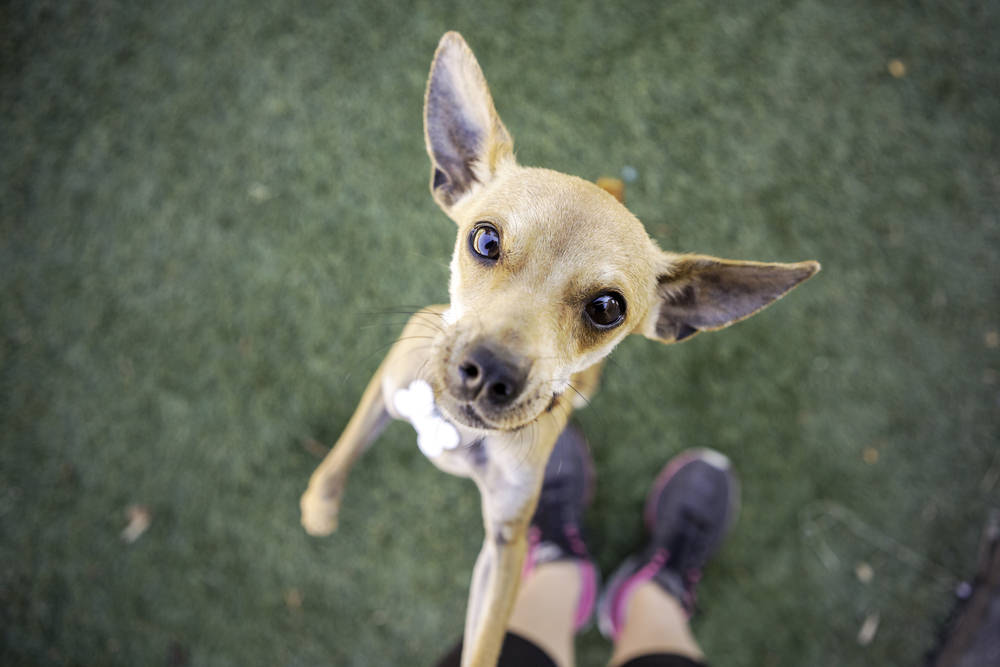
Before they learn to speak, young children often point at an object they want. Any parent can tell you, it is their way of saying, “May I have that, please?”
This type of communication is called “referential signaling” and it is relatively rare among non-primates.

Since dogs have such a unique relationship with humans, the authors of a new study sought to discover if some of their many gestures qualify as referential signaling. They asked 37 dog owners to record their pups attempting to communicate.
242 videos were shot, capturing a total of 49 possible gestures. Of these, the researchers deemed 19 of them referential based on the following standards:
- The request involved an object or a part of the signaler’s body.
- The action doesn’t accomplish anything beyond being a gesture.
- It’s directed at a receiver – the dog owner.
- Its meaning can be taught via repetition to the receiver, who eventually fulfills the request being made.
- It is intentional, with the dog waiting for the desired response after the gesture, and then perhaps amplifying it with additional gestures.

The referential signals were then grouped by their “apparent satisfactory outcome” (ASO) or what the dog was trying to achieve through each gesture. The following four ASOs were isolated:
- “Scratch me.”
- “Give me food/drink.”
- “Open the door.”
- “Get my toy/bone.”
The researchers were only interested in gestures intended to convince the owners to perform one (or more) of these specific actions. They found that many of the dogs’ referential gestures had several meanings. For example, the “paw hover” – holding one paw in mid-air while sitting – could be an attempt to get the human to do any one of the above ASOs.

Below are the researchers’ findings for the meanings behind each of the 19 gestures:
1. Roll Over
Description: Rolling onto one side of the body and exposing the chest, stomach and groin.
What it Means: “Scratch me.”
2. Head Under
Description: Plunge headfirst underneath an object or human.
What it Means: “Get my toy/bone,” “Scratch me,” “Give me food/drink.”
3. Head Forward
Description: Move the head forwards and up to direct a human’s appendage to a specific location on the body.
What it Means: “Give me food/drink,” “Scratch me,” “Open the door.”
4. Hind Leg Stand
Description: Lift front paws off the ground and stand on hind legs, front paws are not resting on anything.
What it Means: “Give me food/drink,” “Get my toy/bone,” “Open the door.”
5. Head Turn
Description: Head is turned from side to side on the horizontal axis usually between a human and an apparent object of interest.
What it Means: “Give me food/drink,” “Open the door,” “Get my toy/bone,” “Scratch me.”
6. Shuffle
Description: Shuffle whole body along the ground in short movements, performed whilst in roll over position.
What it Means: “Scratch me!”
7. Back Leg Up
Description: Lifting of a single back leg whilst lying on one side of the body.
What it Means: “Scratch me!”
8. Paw Hover
Description: Hold one paw in mid-air whilst in a sitting position.
What it Means: “Give me food/drink,” “Scratch me,” “Open the door,” “Get my toy/bone.”
9. Crawl Under
Description: Move entire or part of body underneath an object or a human’s appendage.
What it Means: “Get my toy/bone.”
10. Flick Toy
Description: Hold toy in the mouth and throw it forwards, usually in the direction of a human.
What it Means: “Give me food/drink.”
11. Jump
Description: Jump up and down off the ground, human or an object, usually while staying in one location.
What it Means: “Open the door,” “Give me food/drink,” “Get my toy/bone.”
12. Paw Reach
Description: Placing a single paw or both paws underneath another object to retrieve an object of apparent interest.
What it Means: “Get my toy/bone.”
13. Nose
Description: Pressing nose (or face) against an object or human.
What it Means: “Scratch me,” “Give me food/drink,” “Open the door,” “Get my toy/bone.”
14. Lick
Description: Licking an object or human once or repetitively.
What it Means: “Scratch me,” “Give me food/drink,” “Open the door,” “Get my toy/bone.”
15. Front Paws On
Description: Lifting both paws off the ground and resting them on an object or human.
What it Means: “Open the door,” “Give me food/drink,” “Scratch me,” “Get my toy/bone.”
16. Paw Rest
Description: Lifting a single front paw and resting it on an object or human.
What it Means: “Scratch me,” “Open the door.”
17. Head Rub
Description: Involves rubbing the head against an object or human on which the signaler is leaning on.
What it Means: “Scratch me.”
18. Chomp
Description: Involves opening the mouth and placing it over the arm of a human whilst repeatedly and gently biting down on the arm.
What it Means: “Scratch me.”
19. Paw
Description: Lifting of a single front paw to briefly touch an object or human.
What it Means: “Get my toy/bone.” “Give me food/drink,” “Open the door,” “Scratch me.”
The study’s conclusion points out the remarkable advances in human-canine communication in a relatively short evolutionary time frame:
“The current study has shown that dogs (and humans) are doing something remarkable, having had a shared existence for only 30,000 years. Despite the brevity of this shared existence, dogs have developed a strong relationship with their human social partners, with inter-dependence facilitating successful cross-species communication.
Does your dog perform any of these 19 gestures? Do you agree with the researchers’ findings about their meanings?
H/T to BigThink.com
via Whisker Therapy